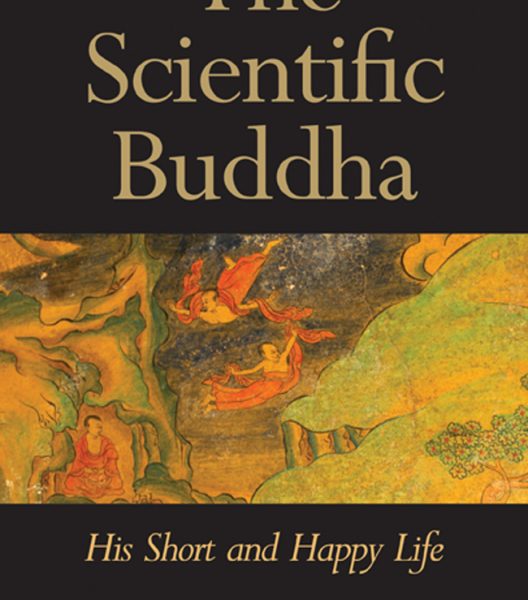The Life and Death of the Scientific Buddha
 When we speak of the “Buddha” in the West today, are we really referring to the one born 2,500 years ago, or are we just invoking a more recent, Westernized incarnation of him? In his latest book, The Scientific Buddha: His Short and Happy Life, Donald S. Lopez, Jr. argues that modern discussions of Buddhism are based not on the teachings of the Buddha of ancient India, but on the Scientific Buddha, who was “born” in Europe in the 1800s. As part of the Terry Lecture Series, which explores religion and its application to human welfare in light of modern science and philosophy, the book examines this updated version of the Buddha, who endorses ideas that seem to be encouragingly compatible with science. His followers go so far as to identify parallels between the doctrine of karma and the theory of evolution; the Buddhist account of the origin of the cosmos and the Big Bang; the doctrine of emptiness and quantum physics. But all this, Lopez counters, is simply false resonance:
When we speak of the “Buddha” in the West today, are we really referring to the one born 2,500 years ago, or are we just invoking a more recent, Westernized incarnation of him? In his latest book, The Scientific Buddha: His Short and Happy Life, Donald S. Lopez, Jr. argues that modern discussions of Buddhism are based not on the teachings of the Buddha of ancient India, but on the Scientific Buddha, who was “born” in Europe in the 1800s. As part of the Terry Lecture Series, which explores religion and its application to human welfare in light of modern science and philosophy, the book examines this updated version of the Buddha, who endorses ideas that seem to be encouragingly compatible with science. His followers go so far as to identify parallels between the doctrine of karma and the theory of evolution; the Buddhist account of the origin of the cosmos and the Big Bang; the doctrine of emptiness and quantum physics. But all this, Lopez counters, is simply false resonance:
“The Scientific Buddha is a pale reflection of the Buddha born in Asia, a Buddha who entered our world in order to destroy it. This Buddha has no interest in being compatible with science.”
One of the main examples Lopez cites is meditation: modern interpretations of Buddhism have turned it into the latest self-help movement for stressed-out consumers in the West, beguiled by a superficial emphasis on “mindfulness.” Meditation has been linked to benefits such as weight loss, lower blood pressure and lower cholesterol. In other words, it’s considered as a therapy for stress reduction—but is stress reduction really what the Buddha taught?
The goal of Buddhist meditation, Lopez explains, is not stress reduction but stress induction:
“The goal of such meditation is to cause one to regard this life as a prisoner regards his or her prison, to cause one to strive to escape from this world with the urgency that a person whose hair is on fire seeks to douse the flames.… Rather than seeking a sense of peaceful satisfaction with the unfolding of experience, the goal of this practice is to produce a state of mind that is highly judgmental, indeed judging this world to be like a prison. This sense of dissatisfaction is regarded as an essential prerequisite for progress on the Buddhist path.”
If the Buddha was simply seeking to alleviate superficial forms of suffering, Lopez writes, “the Buddha would have provided a cure for suffering as science understands it; two millennia ago he would have set forth the Indoor Plumbing Sutra and the Lotus of Good Dental Hygiene.” But the suffering he spoke of was of a subtler nature, and more fundamental to the experience of life.
Having highlighted the dissonances between modern, scientific readings of the Buddha and his original teachings, Lopez goes on to point out that the role of the Scientific Buddha is nonetheless not one that we should discount easily. Having been “born into a world of the colonial subjugation of Asia by Europe,” his existence allowed Buddhist elites of the late nineteenth and early twentieth centuries to counter claims of superstition, “wrest[ing] the weapon of science from the hands of the Christian and turn[ing] it against them.” In this way, Buddhism was able to earn its place among the respected religions of the world.
But now that the Scientific Buddha has played his part, perhaps it’s time for us to let him pass on. Lopez asks if it would really be so bad to conclude that Buddhism, as it was originally conceived, is fundamentally incompatible with science. After all, he says, “Of all the things we have asked of the Buddha, must we also ask him to fulfill the dream of foreigners, a dream that has been dreamed in the West since at least the eighteenth century, the dream of something to believe in that does not make us have to choose between science and religion?” At the end of the day, maybe this dream, this scientific Buddha, is really just that—wishful thinking.



